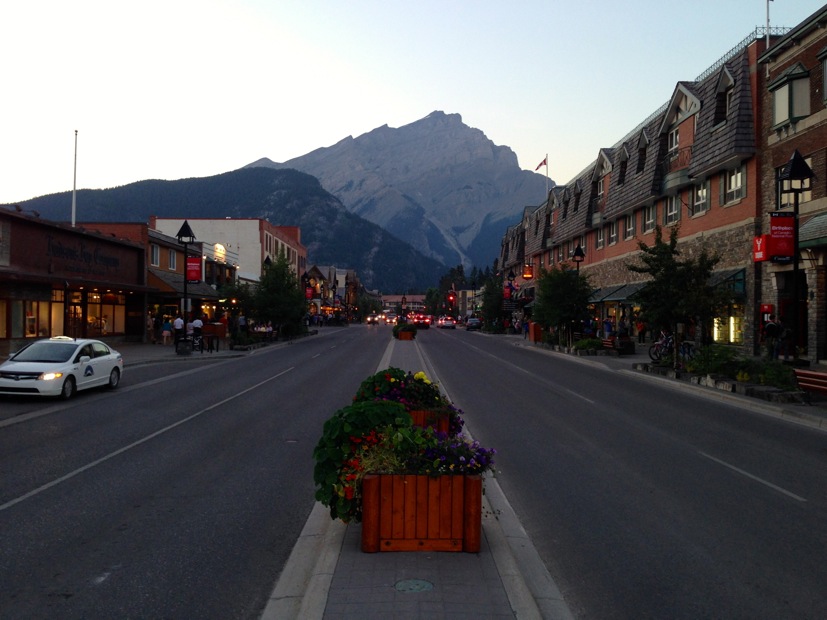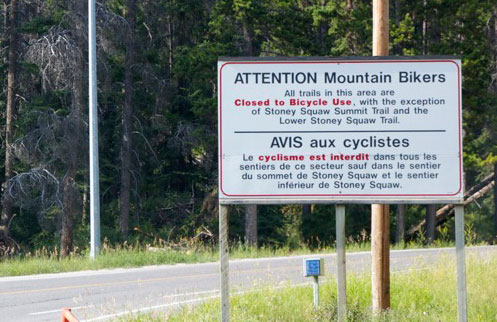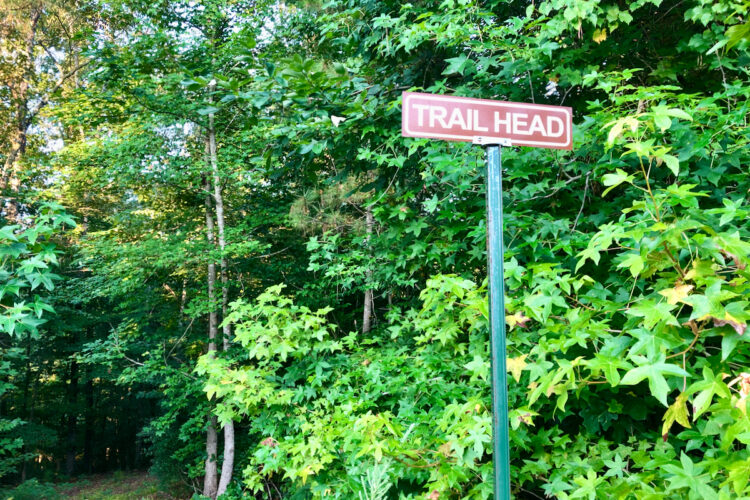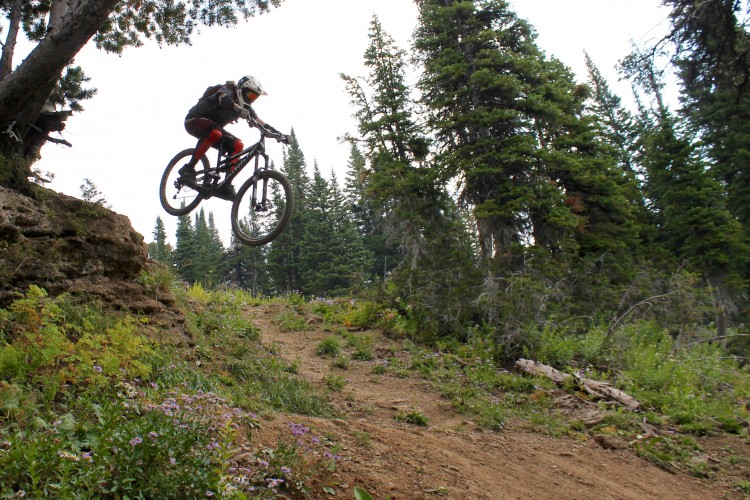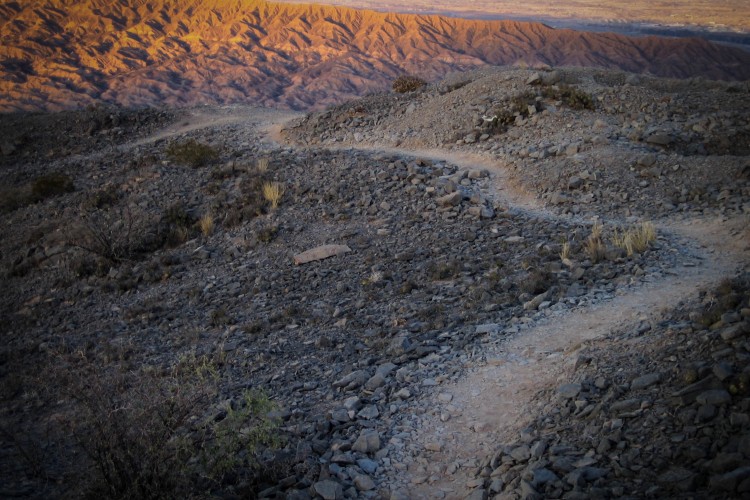Rolling along Topp Notch in Banff, Alberta, it’s hard to believe this trail is located in a National Park. The narrow track snakes its way over boulders, in between trees, and around switchbacks best suited for short wheelbases and 26″ wheels. Honestly the only trails I’ve ridden with this level of creativity and handcrafted quality are unofficial ones, built outside the confines of land managers’ rules for what a mountain bike trail should look like. This is clearly a trail built by mountain bikers–and I can’t believe they pulled it off inside a National Park.
Banff National Park and the town of Banff
Banff National Park was established in 1885 soon after a group of Canadian Pacific Railway workers found hot springs near the new rail line. As just the third National Park in the world, Banff quickly became a popular tourist destination thanks to railroad access and a large hotel built near the hot springs.
Unlike many mountain bike destinations in the western US centered on former mining towns, the town of Banff (elevation: 4,537 feet) has its roots in tourism, which gives the town a noticeably different vibe. Banff receives more than 3 million visitors each year, and we quickly grew accustomed to seeing tour buses unloading dozens of passengers on the main strip throughout the day.
Also unlike many western US mountain bike destinations, Banff sees three quarters of its visits during summer months; in the US, that number is often reversed, with more visitors preferring to ski. There are just over 7,000 permanent residents in Banff and a “need to reside” requirement has created a true community of locals as opposed to a ghost town of vacation homes occupied only once or twice a year.
Mountain biking Banff
Let’s be clear: mountain biking in Banff is all about the scenery. Sure, you can probably find faster or longer or more technical trails other places, but what you can’t duplicate is the scenery in Banff. Rocky peaks seem to cut impossible silhouettes, defying gravity and just about everything I know about topography. Glacial streams and lakes take on eye-popping turquoise tones, like a never-ending flow of Mountain Blast Powerade. Evergreen forests blanket the lower slopes of the mammoth mountain peaks on either side of the valley, a carpet of green moss covering rocks and fallen trees on the ground. This may be the Rocky mountains, but it’s far removed from almost everything I’ve experienced in Colorado.
Greg and I met with Robert Earl, Banff Town Manager and Bow Valley Mountain Bike Alliance (BVMBA) Director to find out how his group was able to get MTB access within a National Park that also happens to be a UNESCO World Heritage site.
“When mountain biking was starting to get big here in the 1990s, people were riding inappropriately on [Mt.] Norquay [within the park and just a few miles outside town]. They would drive up and be riding these wild lines […] and really tearing up the landscape. And so what Parks did was they said mountain biking is illegal in the park unless it’s posted that you can. […] That was really the beginning of the BVMBA.”
The BVMBA worked for six years to gain approval for what would become Topp Notch and Star Wars, the two newest tech trails located on the eastern flanks of Tunnel Mountain. Thousands of volunteer hours–and zero machines–were utilized to build these fun trails that feature everything from berms to ladder bridges and wall rides.
“A whole bunch of [trail user] groups came together to talk about the lands immediately adjacent to Banff. […] Out of that, permission for two new technical trails on the backside of Tunnel [Mountain] was granted. That’s where Star wars and Topp Notch came from. […] Topp Notch is clearly a mountain bike centric trail but the other trails we maintain, we maintain them for all users.”
Greg making his way around one of the tight switchbacks on Topp Notch.
Robert told us about a survey Parks Canada conducted several years ago that found 70% of park visitors like to ride bikes–whether it be cruisers, road bikes, or mountain bikes. The vast majority of park users don’t even venture more than a mile off the pavement during their visit, so clearly mountain biking offers an opportunity to allow guests to experience more of the natural beauty of Banff NP.
Noticeably absent from the Banff mountain biking scene is lift serviced terrain or even commercial shuttle services. We spoke with a number of local riders about this and all seemed to agree that gravity riding has its place… just not in Banff.
“Parks [Canada] has taken the position that they do not support DH riding. They do support technical cross-country, so technical terrain features like you saw on Topp Notch are entirely appropriate. Parks would love to see a situation where all tech terrain features have a ride around.”
Personally, I found it refreshing to experience a destination like Banff owning a particular riding style and not trying to be everything to all types of riders. Banff is the type of place where you can bring your 29er, have a great time, and enjoy exploring epic scenery on two wheels. You won’t find riders with–or even shops renting–AM rigs or full face helmets; leave that to places like Whistler or nearby Golden.
Trails Near the Town of Banff

When people say “Banff,” it’s not always clear whether they’re talking about the National Park (which covers a massive area) or the town itself. Most visitors will choose to base their adventures out of the town of Banff, and this is easily the best area for finding mountain bike trails. In fact, the Tour Divide begins at the Fairmont Hotel in Banff each July as riders head south for the 2,745-mile off-road, single stage race to Antelope Wells, New Mexico.

Andrew Matergio from Soul Bike and Ski was our trail guide in Banff and he started us off on the Tunnel Mountain trail system, which basically wraps itself around the Buffalo Mountain Lodge where we would be staying. Despite being surrounded by peaks soaring thousands of feet into the sky, the Tunnel Mountain trail system features very little elevation gain throughout the network. The trails are fast and well-marked, making this a great keep your-head-up-and-rail kind of a ride.

The Tunnel Bench Loop provided fantastic riding along a rim high above the Cascade River with views of hoodoos and Cascade Mountain to the north. Next, we connected to the Toe Loop for a slightly more technical ride, though strong riders will have no problem negotiating the short, steep climbs, roots, and small rocks here. Various offshoots in the system lead to the Tunnel Mountain Campground and several lodging options, which makes this trail system super accessible.
With the Tunnel Bench Loop and the Toe under our belts, we had covered about 13 miles in 2 hours time, which included many stops for photos. Back at the Buffalo Mountain Lodge, we hydrated and headed up the hill to Topp Notch.
Just off the pavement, there’s a short wooden skinny at the start of Topp Notch which Andrew told us is meant to give riders an idea of what to expect from the loop. The skinny isn’t overly difficult, so if riders are afraid or struggle with it, it’s probably best to avoid riding Topp Notch.
The initial climb features tight switchbacks and narrow trail that’s clearly never been touched by anything wider than a wheelbarrow. Natural materials shore up the trail as it creeps up the steep mountain side, and the hand-built bench cuts ensure that a careful rider can avoid dabbing, even if he isn’t in racing shape. Wooden ladder bridges all serve the utilitarian purpose of getting the rider across larger trail obstacles like rocks and v-shaped gullies.
At the top of the switchbacks, Topp Notch turns downward and whips riders through a series of bermed turns that look like they’re straight out of an MC Escher sketch. Greg and I loved turning through the berms and blasting across a long wooden bridge before turning up for a short climb and descent into a forested boulder field. The trail got tighter and more technical here, with moss covered roots and rocks covering the landscape as far as we could see.
Topp Notch is only about 4 miles long, but it’s some of the highest quality singletrack I’ve experienced in a long time. We climbed back up to the Buffalo Mountain Lodge via Return of the Jedi, tempted to roll around the loop again and again.
The following day I got a chance to ride Star Wars, which is a much shorter trail than Topp Notch, though both essentially share the same trailhead and return via Return of the Jedi (get it?). Star Wars is much more of a freeride trail, with ramps and wall rides constructed for maximum air and adrenaline. Fortunately for me, most obstacles were rollable and all had an easy ride-around. From the bottom of Star Wars I followed the Surprise Corner trail toward town, where the trail went from rim-top singletrack to wide, rooty, and steep down at the river.

Beyond the Tunnel Mountain Trail system, Stoney Squaw on Mt. Norquay is one of the best-known mountain bike trails in the Banff area. The trail is located in an area that was once popular with shuttle riders but today, you’ll generally have the trail to yourself. I dropped Greg off near the top, though he would still have about 1,000 feet to climb and hike-a-bike up to the summit of Stoney Squaw. Greg reported finding some of biggest root webs he’s seen on a trail, though unfortunately he wasn’t able to enjoy the descent down Lower Stoney Squaw after flatting twice and running out of spare tubes.

Though Greg and I stuck to the singletrack and intermediate/advanced-rated trails in our day and a half of riding near Banff, there are at least a dozen bike-legal trails around Banff, several of which are beginner-friendly. There’s even a 9-mile out-and-back connecting Banff to the Canmore Nordic Trails where Greg was able to ride later in our trip (stay tuned!).
As one of the first National Parks in the world, Banff NP continues to lead the way with Topp Notch and Star Wars, two of the first purpose-built mountain bike trails in a National Park. Over the next several days we’ll be sharing more about mountain biking in the Banff area, including travel tips, a ride report from Lake Louise, and Canmore coverage.












